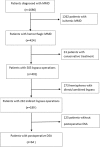Postoperative collateral formation after indirect bypass for hemorrhagic moyamoya disease
- PMID: 31952515
- PMCID: PMC6967087
- DOI: 10.1186/s12883-020-1612-z
Postoperative collateral formation after indirect bypass for hemorrhagic moyamoya disease
Abstract
Background: The research on postoperative collateral formation for hemorrhagic moyamoya disease (MMD) evaluated by using digital subtraction angiography (DSA) is limited. Our study objective was to investigate the postoperative collateral formation after indirect bypass for hemorrhagic MMD.
Methods: All consecutive inpatients with hemorrhagic MMD who received indirect bypass at Beijing Tiantan Hospital, Capital Medical University from January 2010 through December 2018 were screened. The site of the hemorrhage was classified as either anterior or posterior. Postoperative collateral formation was evaluated on lateral views using the Matsushima scale. Univariate and multivariate logistic regression analyses were carried out to determine the factors influencing postoperative collateral formation.
Results: Six-four patients (64 hemispheres) were included in this study. After a median 8.5 months DSA follow-up, 14 (21.9%) hemispheres had grade A collateral circulation, 13 (20.3%) had grade B, and 37 (57.8%) had grade C. Twenty-seven (42.2%) hemispheres had good postoperative collateral formation and 37 (57.8%) had poor postoperative collateral formation. The univariate logistic regression analyses showed that age at operation (OR, 0.954; 95% CI, 0.908-1.003; p = 0.066), hemorrhagic site (OR, 4.694; 95% CI, 1.582-13.923; p = 0.005), and PCA involvement (OR, 3.474; 95% CI, 0.922-13.086; p = 0.066) may effect postoperative collateral formation. The multivariate logistic regression analyses showed that only anterior hemorrhage (OR, 5.222; 95% CI, 1.605-16.987; p = 0.006) was significantly related to good postoperative collateral formation.
Conclusion: Anterior hemorrhage was significantly related to good postoperative collateral formation after indirect bypass.
Keywords: Digital subtraction angiography; Hemorrhage; Indirect bypass; Moyamoya disease; Postoperative collateral formation.
Conflict of interest statement
The authors declare that they have no competing interests.
Figures
References
-
- Scott RM, Smith ER. Moyamoya disease and moyamoya syndrome. N Engl J Med. 2009;360(12):1226–1237. - PubMed
-
- Kuroda S, Houkin K. Moyamoya disease: current concepts and future perspectives. Lancet Neurol. 2008;7(11):1056–1066. - PubMed
-
- Miyamoto S, Yoshimoto T, Hashimoto N, Okada Y, Tsuji I, Tominaga T, Nakagawara J, Takahashi JC. JAM trial investigators: effects of extracranial-intracranial bypass for patients with hemorrhagic moyamoya disease: results of the Japan adult Moyamoya trial. Stroke. 2014;45(5):1415–1421. - PubMed
MeSH terms
LinkOut - more resources
Full Text Sources



